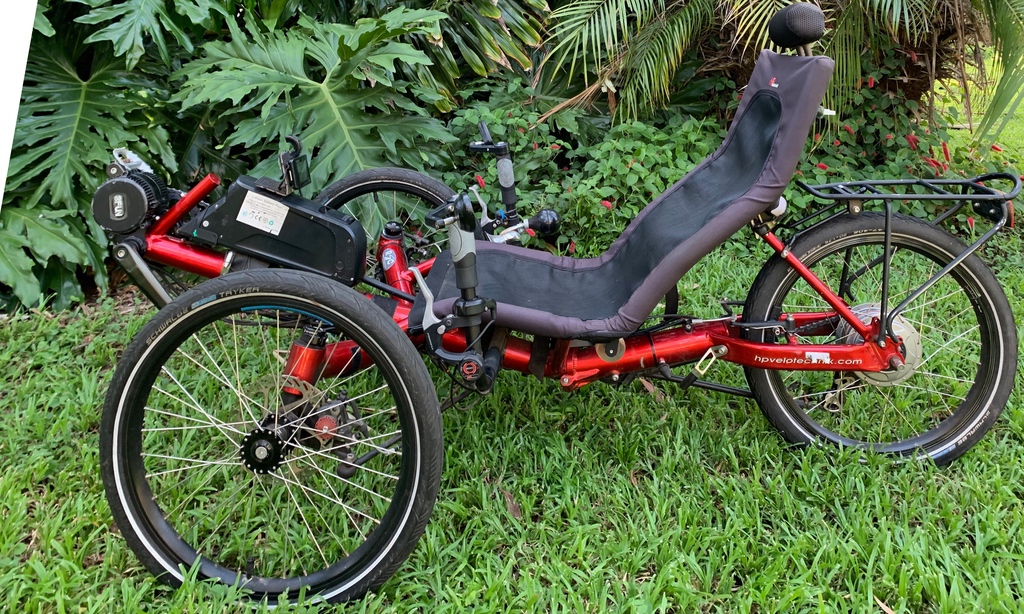
The Bafang Crank or Mid-drive is an e-assist system popular on budget and mid-range recumbent trikes. It is easy to install, easy to use, robust, reliable and low maintenance. Since it replaces the front crankset with a single chainring, it converts a 27-speed trike to 9-speed, 24 to 8 and 21 to 7. It is not an issue when using power but can limit riding without electric help.
Installation

The controller electronics are integrated into the motor assembly, making installation about as simple as it gets. Remove the crankset and bottom bracket. The Bafang motor fits into the bottom bracket mount. You can also remove the front derailleur as it is no longer needed—Route the cabling around the frame using cable ties. For simple installations, fix the battery mount to the rear rack. Bolting the throttle below the hand grips works well. There is a display and a three-button control panel to find locations. With all three closely coupled, you will need to either cut and extend the wires or keep them within 20cm of each other.
Usage
Full-time Assist
I used my HP Velotechnik Gekko with a full-time assist when commuting to work. It came with a 4.5ah battery that would last 45 minutes each way. When I moved to a farther location, I switched to a 17.5ah battery. I don’t know how far that will take me. I was about 100kg at the time, but the route was relatively flat.
Supplementary Assist
Supplementary usually means only turning on assist when a hill is too difficult or uncomfortable to ride otherwise. It could also mean riding until you tire, then using electric help to get home quickly and in comfort.
Limitations

No system is perfect, but the Bafang crank drive is value for money. Most of the limitations listed are common to many electric assistance systems.
- The Bafang system replaces the front chainrings with a single 46 tooth crankset. While perfect for assist, it is close to the highest front gear for human-power locomotion. It means turning on the electricity for all but the shallowest of hills.
- For the economy, the Bafang system uses cadence limiting. The system will provide power for each power level until a specified rpm (cadence). Power is either none or full – so the motor will do almost all the work to the limit, then no more. In practice, you will get minimal exercise while using this system full-time. More sophisticated systems like the Shimano STEPS supply power relative to pedalling hard. These systems feel more natural to ride and provide more exercise unless you dial the assist right up.
- Your trike becomes considerably heavier – making it more difficult to lug around or pack into the back of your car.
- Electrics and electronics add complexity to your pride and joy. Complexity means more systems fail. I have found the Bafang system reliable. I have had one display panel fail, which also causes the power to stop working.
- While the Bafang unit is as waterproof as possible, it is not perfect. I have heard of a motor failing after being repeatedly immersed on an upright bike. It sits higher on a recumbent. If the motor were submerged, the rider would also be. I have ridden mine in heavy rain many times without a problem.
- Forums contain complaints about the boom flexing under assist. I have never experienced this with a 250-watt system. I imagine a 1000-watt motor would put a lot more stress on the drive-train.
My Two Cents on E-Assist
I think too many recumbents have electric assist. Trikes use standard bike components for chainrings and cassettes, making slopes tricky for the riders most attracted to the genre. In other words, climbing hills is challenging, so fork out for an electric motor to help.
A recumbent with an electric motor is no longer a human-powered vehicle. HPV is important to me, although I cannot fully understand why. It is partly to do with getting exercise, partly with freedom, and partly about pride.
If your only concern is hills, try modifying your trike to have lower gears. Join my mailing list to be informed of articles on what is possible and how to do it yourself – or at least ask your bike shop to do it. It should take the same effort on the pedals on a hill as on the flat. Only your speed will change. If you grind up the hill, you are doing neither your muscles nor knees any good.
Let me know of your experiences in the conversation below.

